A Maid Asleep
c. 1656 –1657Oil on canvas
87.6 x 76.5 cm. (34 1/2 x 30 1/8 in.)
Metropolitan Museum of Art, New York
This painting, which is probably Vermeer's earliest genre scene, places a sleeping or inebriated woman in a restricted space between a heavily laden table and a half-opened door leading to a distant light-filled room. The earth tones and deep reds of the palette, as well as the unusual spatial organization, are reminiscent of paintings (fig. 1) by Nicolaes Maes, who influenced Vermeer at this stage of his career. However, unlike Maes, Vermeer neither explains the narrative nor provides a moralizing commentary about the woman's state of being.
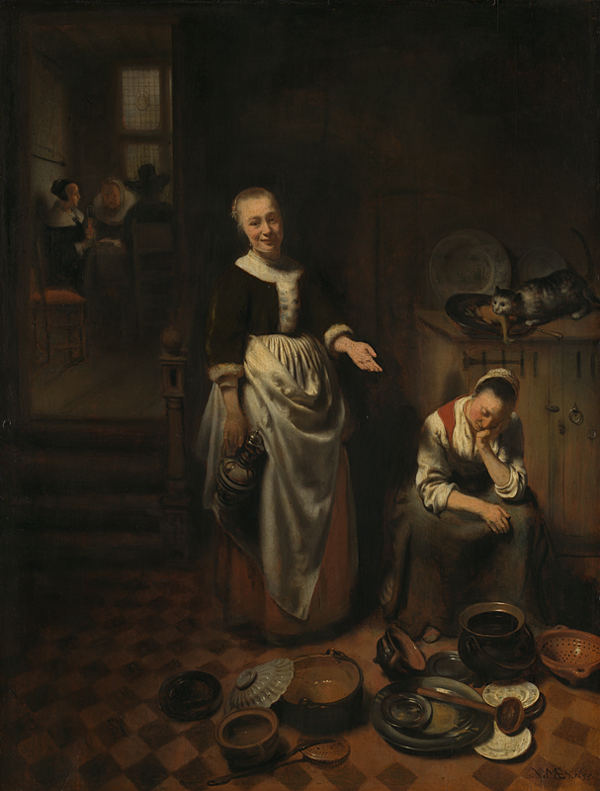
Nicolaes Maes
1655
Oil on oak, 70 x 53.3 cm.
National Gallery, London
Such, however, was not always the case. X-radiographs demonstrate that Vermeer initially included a dog in the doorway and a gentleman in the back room, compositional elements that, were thematically related to the woman's melancholic, or slothful, appearance. The artist, however, painted out these figures, leaving the viewer alone with the woman in a darkened and claustrophobic chamber, without any explanation for her weighty, and even despondent, mood. The elimination of these elements provides an important insight into Vermeer's thought process. They reveal that he sought a poetic image rather than explicit narrative, where the viewer, guided by the figure's melancholic pose, the evocative light effects, and the unusual spatial arrangement, is allowed great latitude in interpreting the scene.
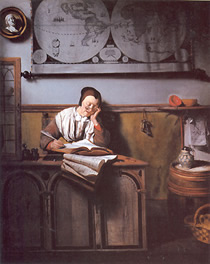
Nicolaes Maes
1656
Oil on canvas, 66 x 53.7 cm.
St. Louis Museum of Art, St. Louis
In A Girl Asleep, the Soldier and Laughing Girl and the Dresden Letter Reader Vermeer's subject matter is stated in a vocabulary not essentially different from that current among his contemporaries. In The Letter Reader the hands are modeled with almost painful attention to their known anatomical form; the same uneasy linear definition of these details appears in the Frick picture. Both reveal the painter experimenting with a manner which is the antithesis of that which he later developed. The Soldier and Laughing Girl is also marked by an unhappy jocularity, an ingredient of the painting of the time which hardly appears again in Vermeer's work. Equally unlike his ultimate style is the Rembrandtesque continuity of modeling in A Girl Asleep.
Both the modeling here and the type of model, with her prominent peak, are reminiscent of Nicolaes Maes. Her pose, too, is characteristic of him; it occurs not only in the picture in the National Gallery called The Idle Servant, (fig. 1), but in the great Lacemaker at Brussels and many others of the early works (fig. 2 & 3). Vermeer may have derived the theme from any of them; it is clear that he profited in the Girl Asleep from both the humane gravity and the inventiveness which Maes learned in the studio of Rembrandt.
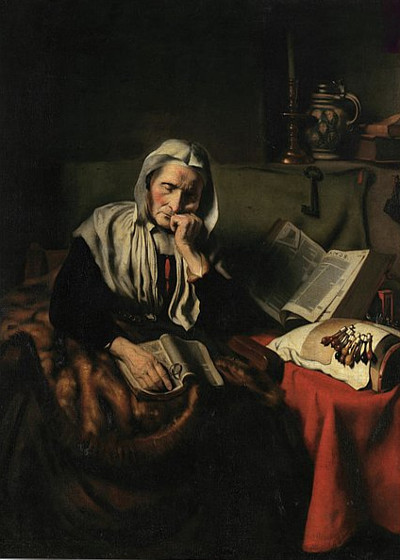
Nicolaes Maes
c. 1656
Oil on canvas, 135x 105 cm.
Koninklijke Musea voor Schone Kunsten van België, Brussels
The vista opening into another room also appears in The Idle Servant (fig. 1); it is often suggested in the work of Rembrandt (fig. 4). But the form in which it is used here is closer to De Hooch. This feature, which became such an integral part of De Hooch's typical compositions, is to be seen in some of his earliest works; its evolution continues throughout his years in Delft and it appears fully developed in a drinking scene in the Rothschild collection painted at about the time of the Girl Asleep and The Procuress. There can be little doubt that De Hooch's example suggested the use of it here. Like the motif from Maes it does not appear in this form in Vermeer's work again.
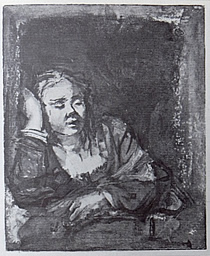
Rembrandt van Rijn
1655–1657
Reed pen and bistre, wash, 82 x 73 mm.
Formerly J. P. Heseltine Collection, London
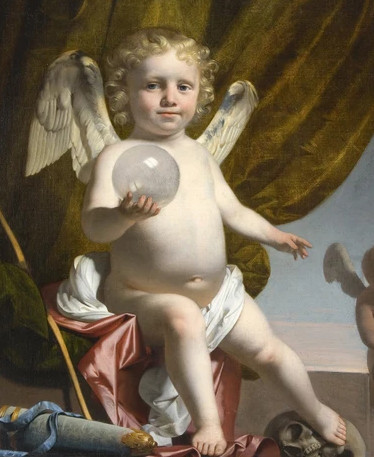
Cesar van Everdingen
c. 1660
Oil on canvas, 89 x 102 cm.
Private collection
The mood of A Girl Asleep is none the less for the first time recognizably Vermeer's own; the girl barely visible behind the furniture, inactive, wrapped up in herself, even the barely perceptible intrusive note provided by the mask in the picture on the wall (fig. 7), both belong to his world and no other. There were to be many more lucid expositions of it. The picture on the wall later becomes familiar; it is the Cupid in the style of Caesar van Everdingen (fig. 5) which is seen again in the Frick music scene and in one of the pictures in the National Gallery. It then becomes clear that the mask was specially added for the purpose of the Girl Asleep. It illuminates the theme with a typical reference; sleep admits a fantasy of love.
This Girl Asleep was, it seems probable, item 8 in the Van Ruijven Dissius sale of 1696 identified as "a drunken, sleeping maid at a table, by the same." The evidence that the young woman in the Metropolitan painting is, indeed, drunken, is there on the table before her, in the form of not one but two glasses and a wine jug (fig. 6). A small wine-glass suitable for a young woman stands almost empty within her reach. The overturned glass at the near side of the table beside the white wine jug is a roemer (or rummer) of the kind used by men. Neither glass is immediately obvious. The woman's glass appears to be intentionally concealed, being almost submerged within the brilliant reds of the carpet, but the overturned rummer has been abraded by overzealous cleaning, or, possibly, to remove obvious signs of indulgence. It has been suggested that the roemer is an addition by a later hand, painted aver the bowl that Vermeer had placed there. But several of the objects on the table are difficult to make out. This is partly because the paint surface has been damaged. Even the prominent white wine jug is much worn. But it is also because Vermeer has already begun to demand close attention from his viewer. At the near edge of the table there appear to be not one but, two pieces of tableware: a knife, it must be, lies with its handle poised aver the table edge, while resting against the great rising fold in the carpet is a spoon or fork. The two utensils meet, knife-point with bowl or tines, but their meeting appears to be obscured by the diaphanous folds of a chiffon-like fabric that also half-conceals an overturned white jug. On closer attention, it can be seen that, time and wear apart, the principal source of concealment is the angle of sight from which objects are presented to the viewer. From the perspective offered, only the slender profile of the spoon or fork can be seen and even that profile is identified with the edge of the chiffon fabric. The tip of the knife may, or may not, tuck beneath the fabric. Already, in a technique he was soon to turn away from, Vermeer sets his viewer perceptual challenges. To discern the wine-glass, against the gaudy pattern of the carpet; to distinguish the profile of the spoon or fork from the rhythm of the fabric's fold; to notice that half concealed among the curves of the chiffon drapery are the curves of an overturned jug; to discriminate two nut-like objects lying a few inches in front of the fingertips of the sleeping girl's left hand from the pattern of the carpet: these are challenges that may lead us to consider the nature of our purchase on the world through sight.
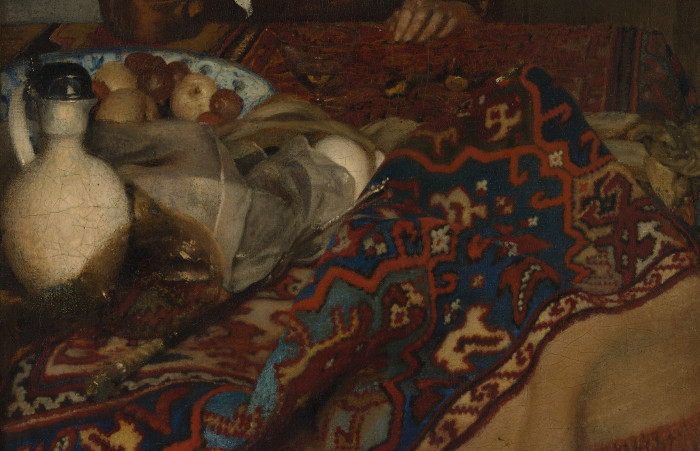
Johannes Vermeer
They may lead us to reflect on what seems so certain, so obvious, as not to call for reflection. In the foreground, the carpet on the table rears up in a great ruck like a pyramid before the receding horizontal plain of the table top. On the right, the back of a chair looms almost within reach and beyond it extends a great depth, through a door, across a corridor and across the expanse of a further room. Such things are clear. The world is extension. So, as we turn and attend to it, we see, we recognize, the nearness and distance of things. That Vermeer can set such an extensive view before our eyes by applying paint to a small, vertical, canvas panel may seem magical. But it can also seem so self-evident an achievement that we accept it without question, as we accept our vision of the world itself. It is when we recognize that some things are not clear and that, contrary to the actual world, nothing we can do will make them clearer that we may come to examine more thoughtfully the distinctive character of Vermeer's image.
The painting on the wall above the Girl Asleep allows us to see part of the left leg of a standing child together with a mask in deep shadows (fig. 7 ). The figure has been recognized as a standing putto or Cupid holding up a card, in the style of Cesar van Everdingen, which reappears in Girl Interrupted at Her Music in the Frick collection, and A Standing Lady at the Virginal, in both cases without a trace of a mask. The mask signifies dissimulation or deceit. Is the girl feigning to be asleep? And if so, why? If she is supposed to be a "drunken maid asleep at a table," as the 1696 sales catalogue of the Dissius collection described her, what is she pretending to be that she is not? The mask standing upright faces the putto, the incarnation of love. Rather than being drunk, she may be feigning sleep as her lover is about to appear. Was it him that Vermeer first painted standing in the back of the room, seen through the door, but then painted over? Pretense and dissimulation imply the existence of at least two actors in the drama: the abuser and the abused. If this interpretation holds up, the painting is situated in the same general territory as Diana and Her Companions: scenes where the impending presence of a protagonist supplies the otherwise missing tension.

Johannes Vermeer
Since a painting of a putto was mentioned in the inventory of movable goods taken after Vermeer's death in February 1676, the one represented above the head of the sleeping girl may have belonged to the Thins-Vermeer household at the end of the artist's life. The fact that it was in the part of the estate that Maria Thins shared with Catharina Bolnes does not imply that it had always been there. It only gives us a very tentative hint that by the time the Girl Asleep at a Table was painted, Vermeer was already living in the Thins household. The presence of the chair with lion-head finials, which reappears in many of his later paintings, adds to this presumption.

Lisa Vergara
"Perspectives on Women in the Art of Vermeer"The Cambridge Companion to Vermeer (Cambridge Companions to the History of Art)
2001, pp. 68–69
His own first essay of this kind, A Woman Asleep at a Table, was bought by a well-to-do Delft couple, Pieter Claesz. van Ruijven and Maria de Knuijt. Eventually, they owned as many as twenty-one of Vermeer's rare paintings, nearly half his estimated lifetime production, probably acquiring each piece as soon as the oil was sufficiently dry. Van Ruijven and de Knuijt owned the Woman Holding a Balance, for example, as well as An Officer and a Laughing Girl and The Music Lesson. Their distinguished art collection consisted entirely of depictions of nativist Dutch subjects, painted by masters who were associated with Delft. Van Ruijven had reason to bolster his social prestige, and it seems plausible that in patronizing Vermeer he was following the example of his high-class relative, Pieter Spiering Silvercroon. The latter was the patron of Gerrit Dou (1613–1675), one of the best-remunerated Dutch painters of the century. Spiering had an arrangement to pay Dou 500 guilders a year, apparently for the right of first refusal on this sought-after master's works (whose subjects were mostly modern). Philips Angel, in his Praise of Painting of 1642, writes of Spiering's arrangement with Dou. In his account, within the ranks of such fabled patrons of antiquity and the Renaissance as King Attalus, Alexander, Caesar, the Emperor Maximilian, Julius Il, and Francis I, the only Dutchman named is Spiering. By emulating him, Van Ruijven must have hoped to improve his social luster by linking his name to that of an outstanding local talent—Vermeer—and more generally, by assembling a choice art collection.



